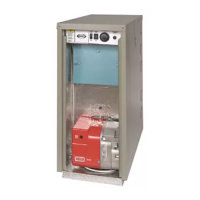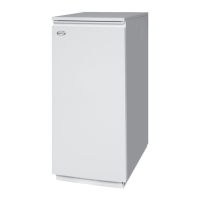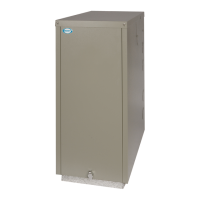32
Grant Vortex External Module
7 - COMMISSIONING
It is important that the following commissioning
procedure is carried out to ensure safe and efficient
operation of the boiler.
1 Check that the water system has been vented (and
pressurised if sealed system) and there are no leaks.
Ensure the flow pipe has been vented.
2 Check that all fuel line valves are open.
3 Remove the plastic burner cover (two screws) if it
was not previously removed.
4 Connect a combined vent manifold and pressure
gauge to the pressure gauge connection port on the oil
pump. See Fig. 21. Open the vent screw on your vent
manifold to vent the supply while the pump is running.
5 Check that all system controls are calling for heat and
turn the boiler thermostat to maximum. Switch on the
electricity supply.
Note: The boiler will start as soon as the electricity
supply to it is switched on.
6 The burner fan should start and the burner should
light within about 12 seconds. If the burner does
not light and the 'Lock-out' reset button lights, wait
for about 45 seconds then press the reset button to
restart the ignition process. This procedure may
have to be repeated several times during first
lighting.
7 With the burner alight, check the fuel pressure.
Refer to the Technical Information, Section 3.3.
Adjust the pressure if necessary - see Fig. 21.
8 Operate the boiler until it reaches normal operating
temperature. Check oil supply/return pipe for leaks,
rectifying where necessary.
9 Check the operation of the boiler thermostat.
Ensure that by turning it anticlockwise it switches
the burner off.
10 With the burner alight, re-check the fuel pressure
and re-adjust if necessary. Turn the boiler off,
remove the pressure gauge and replace the plug in
the pump.
11 Having ensured that there are no oil leaks, replace the
burner cover.
12 Relight the boiler and allow it to run for 20
minutes.
Insert combustion probe into the end of the flue
terminal to measure the CO
2
level.
Do not use the boiler test point.
13 Check the smoke number, if satisfactory check the
CO
2
. Set the CO
2
to the value given in Section 3.3
for the boiler concerned.
Use the hexagonal key supplied to adjust the
burner air damper (see Fig. 21) as required.
Turning the screw anti-clockwise closes the
damper and increases CO
2
level, turning the screw
clockwise opens the damper and reduces CO
2
level.
Re-check the smoke number if the damper has been
moved. Under no circumstances must the smoke
number be above 1.
Note: It is important that the air damper is
correctly set.
Note: To obtain the correct CO
2
level, the final
flue gas reading must be taken with all casing
panels fitted.
14 Check the flue gas temperature.
15 When the boiler has been adjusted and is running
satisfactorily, balance the central heating system by
adjusting the radiator lock shield valves. Start with
the radiator nearest the boiler and adjust the valves
to achieve the required temperature drop across
each radiator. If thermostatic radiator valves have
been installed, check the system by-pass.
16 Switch off the boiler.
17 With the system hot, check again for leaks,
rectifying where necessary. Drain the system while
it is hot to complete the flushing process. Refill and
vent (and pressurise if a sealed system) the system.
18 A suitable central heating system inhibitor must be
added to protect the system against the effect of
corrosion.
19 Replace the top, front and rear panels.
Note: After commissioning the boiler complete the
boiler passport that comes supplied with the boiler and
return the commissioning details to Grant Engineering
(IRL) Ltd..
If the boiler is to be left in service with the User, set
the controls and room thermostat (if fitted) to the
User's requirements.
If the boiler is not to be handed over immediately,
close the boiler fuel supply valve and switch off the
electricity supply.
If there is any possibility of the boiler being left during
frost conditions, then the boiler and system should be
drained.
